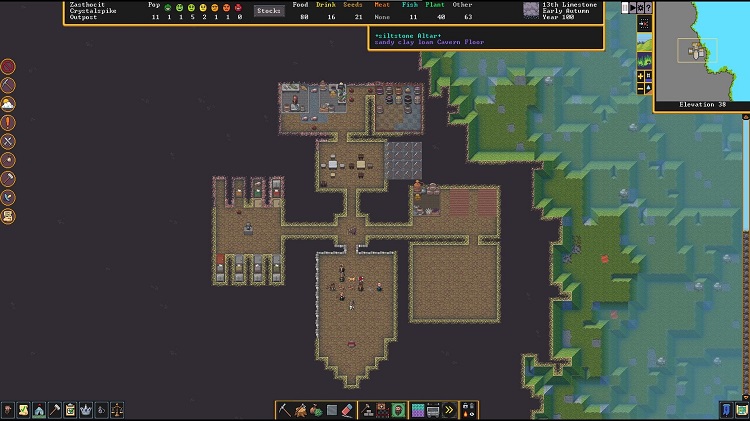Dwarf Fortress Review
Dwarf Fortress is a game of incredible depth, generating stories that are both hysterical and poignant. But that depth has been locked behind an accessibility barrier of text-based ASCII graphics and arcane keyboard shortcuts requiring multiple wikis to penetrate.
This premium release on Steam brings new graphics and a host of quality-of-life improvements that finally make the game approachable. But the learning curve remains steep.

Gameplay
Dwarf Fortress is a pioneer in its genre; it set the bar so high that other games copy and rehash it for years afterwards, still hoping to capture a fraction of its magic. It has a huge number of variables, including weather, seasons, biomes and over 50 trees that produce food. Every dwarf has a personality and preferences that impact how they work, interact with others and their mood.
It is easy to get overwhelmed by how many things are happening. There is a learning curve as you figure out the best way to mark tunnels for mining, select furniture to place in your rooms and assign managers to oversee all the other tasks that your dwarves must perform. Each dwarf has a mood and memories, and it is important to keep them happy. You can do this by improving rooms, providing entertainment at the tavern, and building temples for their various deities. The happier your dwarves are, the fewer issues you will have.
Graphics
While the core gameplay has been around for sixteen years, Dwarf Fortress remains a hard sell to the uninitiated. This management simulation imposes an incredibly demanding mental tax, from the mechanical density of the game’s mechanics to the enormous flurries of activities that occupy the screen in almost constant motion. Floods, cave-ins, plagues, wars, and insurrections are just a few of the many events that can happen to your colony.
The Steam release removes a significant barrier to entry, with refreshed graphics that replace the inscrutable ASCII text with sprites for each dwarf’s physical characteristics and the tiles and structures that form their world. That visual overhaul, along with some welcome quality-of-life improvements, fundamentally opens the game up to a new generation of players.
The question is whether these changes can offset the inevitably dry and logistics-heavy nature of resource management and goods crafting. The answer is probably yes, but not for everyone. The premium version also offers a variety of flexible options that let you tailor the size and complexity of your world upon starting a new game and adjust population frequencies and the presence of enemy creatures and wildlife.
Soundtrack
Among the pantheon of cult classics, Dwarf Fortress is an amazing example of depth that is unmatched by any modern game. Yet, it also carries with it an unforgiving wall of inaccessibility – from text-based ASCII graphics and arcane keyboard controls to an impenetrable maze of mods and tilesets.
Luckily, this premium release of the 20-year-old magnum opus offers a fresh coat of paint overlaid with a lively soundtrack. Dwarf Fortress’s soundscape now features a wide range of natural sounds, dwarven work and tavern chatter, and whistling cavern winds. It’s a welcome change that fits with the legacy of the game while adding a sense of place to your adventures.
The reworked visuals aren’t meant to replace the deep action that takes place behind the scenes. While notifications and a redesigned user interface help, it’s still up to the player to dig through event logs and life histories in order to understand what is happening.
Controls
Dwarf Fortress isn’t for everyone; it demands a willing buy-in from its players. It’s a machine made by dedicated craftspeople over decades, tuned to do one thing well: generate worlds that fill the mind with treasure and adventure.
Its procedurally generated worlds are brimming with life – creatures, plants, materials, civilizations, artefacts, gods and religions, music and stories – with a history that stretches back centuries before the “present day” you start in. You control the fortress, fighting goblin invasions and undead hordes, meeting the needs of annual trading caravans, and developing underground farming with customized crops like “plump helmet” mushrooms.
The game’s premium release on Steam brought a much-needed update to its controls, adding mouse support, a fully-fledged graphical interface and setting menus (rather than having to directly edit the game files if you want to adjust the difficulty). This alone makes it worth playing. But it also enables better visual feedback on the status of your colony – like a fortress in need of more boots because some dwarves are wearing too few.
